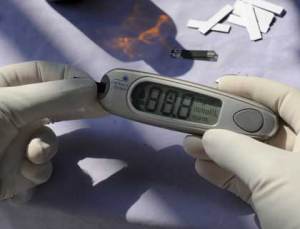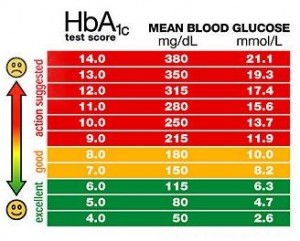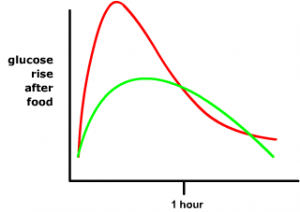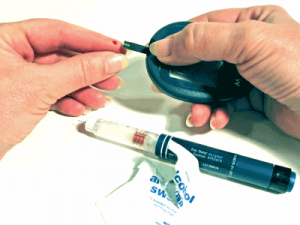What are Normal Blood Sugar Levels?
Diabetes Testing Numbers
Diabetes testing numbers are very important for those people with diabetes. In today’s world, more and more people are becoming diabetic largely due to the amount of sugar in the average American diet. Diabetes is a disease where the body’s organ known as the pancreas manufactures too little of a chemical known as insulin.
Insulin is used by the body to convert the glucose (sugar) in the blood into fuel that the body can use. When the insulin levels are low the sugar levels are high and this can cause a lot of damage to the body as at too high a level, sugar can become a poison killing the body slowly.
The damage associated with high blood sugar includes heart damage and the risk of getting heart disease, eye damage/blindness, nerve damage, and kidney damage. These factors make diabetes a deadly and very serious disease. So, what should an average person’s diabetes testing numbers be compared to that of a diabetic?
 What are Normal blood sugar levels for non-diabetics?
What are Normal blood sugar levels for non-diabetics?
For most people who are non-diabetic healthy individuals, their blood glucose levels would vary during the day, depending on whether it is premeal, or two hours after eating. Generally, premeal levels would be the lowest. For some, 60 mg/dL is normal, for others, 90 mg/dL is also normal.
Most people that don’t have diabetes would sit around :
Fasting – 72 – 99mg/dL (4.0 to 5.4 mmol/L)
2 hours after eating – Up to 140 mg/dL (7.8 mmol/L)
 What is a Good Blood Sugar Level for Diabetes Type 2?
What is a Good Blood Sugar Level for Diabetes Type 2?
Good blood sugar levels for the average person with diabetes should be between 60.8 mg/dl and 120.4 mg/dl ( 3.4 to 6.7mmol/L) depending on the time of day and amount in the last meal.
However, with diabetes type 2, your glucose levels can be anywhere from 120.8 to 200 mg/dl (6.7 to 11.1mmol/L)
At these levels, the body suffers damage. In order to keep the body from reaching these extremes, it must be monitored with a blood glucose meter. There are many different versions around nowadays, some are watches, and some require no needle finger pricks.
Check HERE for the top 5 companies developing non-invasive glucose monitors in 2022.
 What are random blood sugar levels?
What are random blood sugar levels?
A random blood glucose test is where a small amount of blood is taken and added to a blood testing strip and tested at any given time of the day. This type of random blood testing is really quite essential for a diabetic, as it can indicate how well they are managing the disease.
Non-diabetic random blood levels – would be below 200 mg/dL (11.1mmol/L)
Diabetes random blood levels – would be above 200 mg/dL (11.1mmol/L)
 What are Blood sugar levels 2 hours postprandial?
What are Blood sugar levels 2 hours postprandial?
To start with, postprandial means after lunch or dinner. So the “PPG concentrations” are referring to the Plasma glucose concentrations after eating.
Non-diabetic 2 hours after eating – should be below 140mg/dL (7.8mmol/L)
Diabetic 2 hours after eating – should be below 180 mg/dl (10.mmol/L)
 What are Fasting blood sugar levels
What are Fasting blood sugar levels
A fasting blood sugar level is taken after you have fasted (not eaten) overnight. It is important that you have had nothing to eat or drink, apart from water, for approximately 8 hours. This particular test will help your doctor, or health care professional to determine whether you have diabetes or not.
Normal Result – Fasting Blood glucose test – less than 100 mg/dL (5.6 mmol/L)
Prediabetes Result – Fasting blood glucose – 100 to 125 mg/dL (5.6 to 6.9 mmol/L)
Diabetes Result – Fasting blood sugar test – 126 mg/dL (7 mmol/L) or higher on two separate tests.
 Normal blood sugar levels During pregnancy
Normal blood sugar levels During pregnancy
If you have diabetes and you are pregnant, you need to be very strict with checking your blood sugar levels. Your doctor or obstetrician will ask you to monitor prior to meals, 1 or 2 hours after meals, and then also additional times such as prior to going to bed and even overnight.
You will need to keep good records of these results to give your team a better understanding of your sugar levels, so you can adjust your insulin levels accordingly.
Recommended level target during pregnancy – Fasting 4.0–5.5 mmol/L
Recommended level target during pregnancy – 2 hours after meal 5.5–7.0 mmol/L
So How Can we all Lower our Blood glucose Level Naturally?
- Ensure you always monitor your blood sugar levels
- Drink plenty of water and stay well hydrated
- Try and control your stress levels – perhaps do some meditation or yoga.
- Make healthy food choices – control your carb intake and choose low-GI foods.
- Cut down on your meal portions
- Increase your fiber intake
- Very importantly, regular exercise. This will assist with weight loss as well as increase your insulin sensitivity.
When you buy through links on our website, we may earn a small commission at no cost to you. Thanks for your support 🙂









